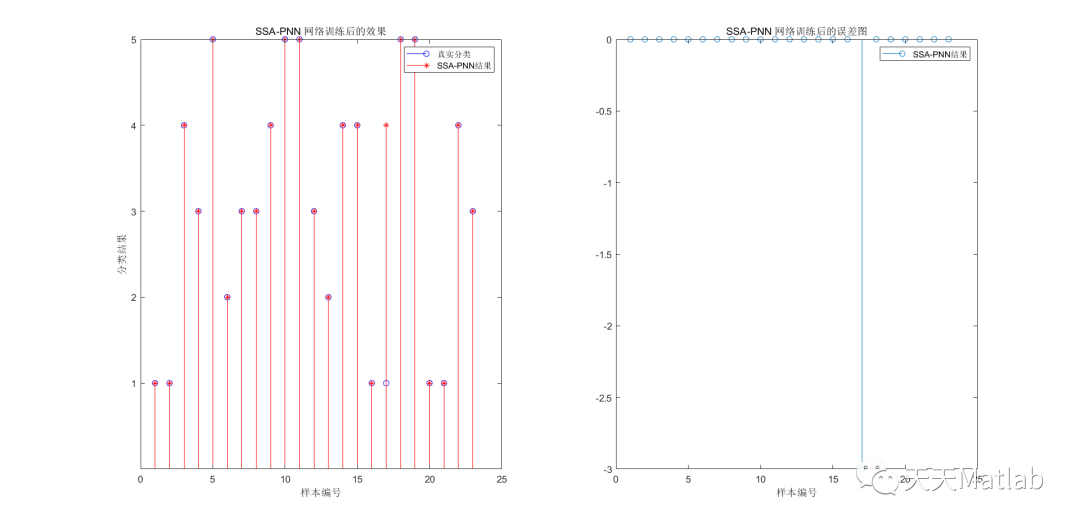概率神经网络(Probabilistic Neural Network,简称PNN)是利用贝叶斯定理和基于风险最小的贝叶斯决策规则对新样本进行分类的神经网络,具有训练时间短且不易收敛到局部极值的优点,但是传统PNN采用相同平滑系数容易导致识别率低和误分类的问题,其次平滑系数对分类结果影响巨大并且难以确定,模式层神经元数目由训练样本数目确定,当训练样本集规模巨大时,导致网络结构复杂。本文麻雀算法选择PNN网络的平滑系数向量并优化PNN的网络结构.
function [fMin , bestX, Convergence_curve] = SSA(X, N, M, c, d, dim, fobj)P_percent = 0.2; % 发现者的种群规模占总种群规模的百分比pNum = round(N*P_percent); % 发现者数量20%SD = pNum/2; % 警戒者数量10%ST = 0.8; % 安全阈值lb = c.*ones(1, dim); % 下限ub = d.*ones(1,dim); % 上限% 初始化for i = 1:N% X(i, :) = lb + (ub - lb) .* rand(1, dim); fitness(i) = fobj(X(i, :));endpFit = fitness;pX = X; % 与pFit相对应的个体最佳位置[fMin, bestI] = min(fitness); % fMin表示全局最优解bestX = X(bestI, :); % bestX表示全局最优位置%% 迭代寻优for t = 1 : M [~, sortIndex] = sort(pFit); % 排序 [fmax, B] = max(pFit); worst = X(B, :); %% 发现者位置更新 r2 = rand(1); if r2 < ST for i = 1:pNum % Equation (3) r1 = rand(1); X(sortIndex(i), :) = pX(sortIndex(i), :)*exp(-(i)/(r1*M)); X(sortIndex(i), :) = Bounds(X(sortIndex(i), :), lb, ub); fitness(sortIndex(i)) = fobj(X(sortIndex(i), :)); end else for i = 1:pNum X(sortIndex(i), :) = pX(sortIndex(i), :)+randn(1)*ones(1, dim); X(sortIndex(i), :) = Bounds(X(sortIndex(i), :), lb, ub); fitness(sortIndex(i)) = fobj(X(sortIndex(i), :)); end end [~, bestII] = min(fitness); bestXX = X(bestII, :); %% 跟随者位置更新 for i = (pNum+1):N % Equation (4) A = floor(rand(1, dim)*2)*2-1; if i > N/2 X(sortIndex(i), :) = randn(1)*exp((worst-pX(sortIndex(i), :))/(i)^2); else X(sortIndex(i), :) = bestXX+(abs((pX(sortIndex(i), :)-bestXX)))*(A'*(A*A')^(-1))*ones(1, dim); end X(sortIndex(i), :) = Bounds(X(sortIndex(i), :), lb, ub); fitness(sortIndex(i)) = fobj(X(sortIndex(i), :)); end %% 警戒者位置更新 c = randperm(numel(sortIndex)); b = sortIndex(c(1:SD)); for j = 1:length(b) % Equation (5) if pFit(sortIndex(b(j))) > fMin X(sortIndex(b(j)), :) = bestX+(randn(1, dim)).*(abs((pX(sortIndex(b(j)), :) -bestX))); else X(sortIndex(b(j)), :) = pX(sortIndex(b(j)), :)+(2*rand(1)-1)*(abs(pX(sortIndex(b(j)), :)-worst))/(pFit(sortIndex(b(j)))-fmax+1e-50); end X(sortIndex(b(j)), :) = Bounds(X(sortIndex(b(j)), :), lb, ub); fitness(sortIndex(b(j))) = fobj(X(sortIndex(b(j)), :)); end for i = 1:N % 更新个体最优 if fitness(i) < pFit(i) pFit(i) = fitness(i); pX(i, :) = X(i, :); end % 更新全局最优 if pFit(i) < fMin fMin = pFit(i); bestX = pX(i, :); end end Convergence_curve(t) = fMin; disp(['SSA: At iteration ', num2str(t), ' ,the best fitness is ', num2str(fMin)]);end%% 边界处理function s = Bounds(s, Lb, Ub)% 下界temp = s;I = temp < Lb;temp(I) = Lb(I);% 上界J = temp > Ub;temp(J) = Ub(J);% 更新s = temp;


免责声明:本文系网络转载或改编,未找到原创作者,版权归原作者所有。如涉及版权,请联系删